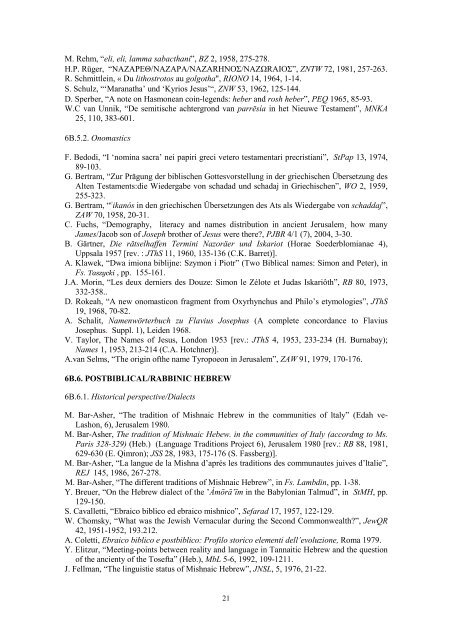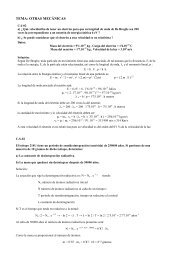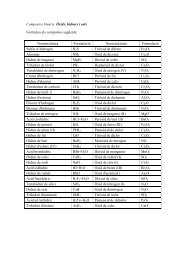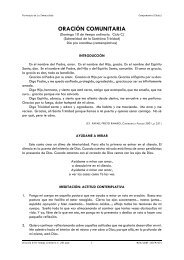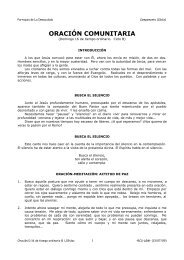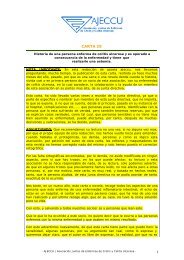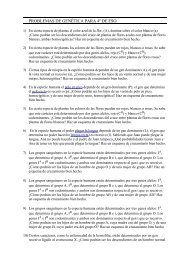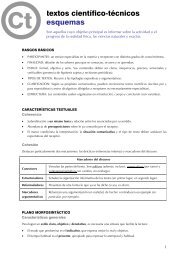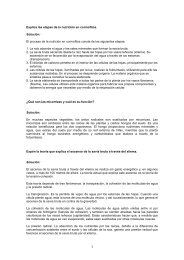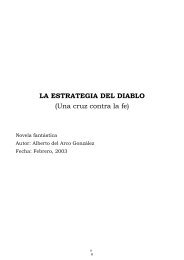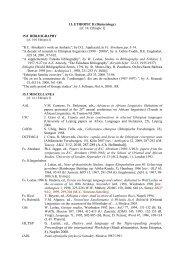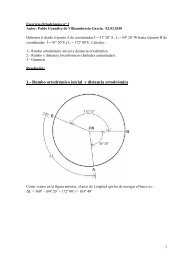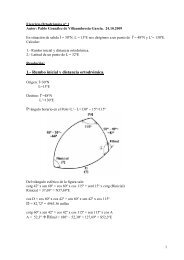BIB-SEM.6HB-dial _2010 - Telefonica.net
BIB-SEM.6HB-dial _2010 - Telefonica.net
BIB-SEM.6HB-dial _2010 - Telefonica.net
You also want an ePaper? Increase the reach of your titles
YUMPU automatically turns print PDFs into web optimized ePapers that Google loves.
M. Rehm, “eli, eli, lamma sabacthani”, BZ 2, 1958, 275-278.<br />
H.P. Rüger, “NAZAPEΘ/NAZAPA/NAZARHNOΣ/NAZΩRAIOΣ”, ZTW 72, 1981, 257-263.<br />
R. Schmittlein, « Du lithostrotos au golgotha", RIOO 14, 1964, 1-14.<br />
S. Schulz, “‘Maranatha’ und ‘Kyrios Jesus’“, ZW 53, 1962, 125-144.<br />
D. Sperber, “A note on Hasmonean coin-legends: heber and rosh heber”, PEQ 1965, 85-93.<br />
W.C van Unnik, “De semitische achtergrond van parrēsía in het Nieuwe Testament”, MKA<br />
25, 110, 383-601.<br />
6B.5.2. Onomastics<br />
F. Bedodi, “I ‘nomina sacra’ nei papiri greci vetero testamentari precristiani”, StPap 13, 1974,<br />
89-103.<br />
G. Bertram, “Zur Prägung der biblischen Gottesvorstellung in der griechischen Übersetzung des<br />
Alten Testaments:die Wiedergabe von schadad und schadaj in Griechischen”, WO 2, 1959,<br />
255-323.<br />
G. Bertram, “ c ikanós in den griechischen Übersetzungen des Ats als Wiedergabe von schaddaj”,<br />
ZAW 70, 1958, 20-31.<br />
C. Fuchs, “Demography, literacy and names distribution in ancient Jerusalem¸ how many<br />
James/Jacob son of Joseph brother of Jesus were there?, PJBR 4/1 (7), 2004, 3-30.<br />
B. Gärtner, Die rätselhaffen Termini azoräer und Iskariot (Horae Soederblomianae 4),<br />
Uppsala 1957 [rev. : JThS 11, 1960, 135-136 (C.K. Barret)].<br />
A. Klawek, “Dwa imiona biblijne: Szymon i Piotr” (Two Biblical names: Simon and Peter), in<br />
Fs. Taszycki , pp. 155-161.<br />
J.A. Morin, “Les deux derniers des Douze: Simon le Zélote et Judas Iskariôth”, RB 80, 1973,<br />
332-358..<br />
D. Rokeah, “A new onomasticon fragment from Oxyrhynchus and Philo’s etymologies”, JThS<br />
19, 1968, 70-82.<br />
A. Schalit, amenwörterbuch zu Flavius Josephus (A complete concordance to Flavius<br />
Josephus. Suppl. 1), Leiden 1968.<br />
V. Taylor, The Names of Jesus, London 1953 [rev.: JThS 4, 1953, 233-234 (H. Burnabay);<br />
ames 1, 1953, 213-214 (C.A. Hotchner)].<br />
A.van Selms, “The origin ofthe name Tyropoeon in Jerusalem”, ZAW 91, 1979, 170-176.<br />
6B.6. POST<strong>BIB</strong>LICAL/RABBIIC HEBREW<br />
6B.6.1. Historical perspective/Dialects<br />
M. Bar-Asher, “The tradition of Mishnaic Hebrew in the communities of ltaly” (Edah ve-<br />
Lashon, 6), Jerusalem 1980.<br />
M. Bar-Asher, The tradition of Mishnaic Hebew. in the communities of Italy (accordmg to Ms.<br />
Paris 328-329) (Heb.) (Language Traditions Project 6), Jerusalem 1980 [rev.: RB 88, 1981,<br />
629-630 (E. Qimron); JSS 28, 1983, 175-176 (S. Fassberg)].<br />
M. Bar-Asher, “La langue de la Mishna d’aprés les traditions des communautes juives d’ltalie”,<br />
REJ 145, 1986, 267-278.<br />
M. Bar-Asher, “The different traditions of Mishnaic Hebrew”, in Fs. Lambdin, pp. 1-38.<br />
Y. Breuer, “On the Hebrew <strong>dial</strong>ect of the ’Ámōrā’īm in the Babylonian Talmud”, in StMH, pp.<br />
129-150.<br />
S. Cavalletti, “Ebraico biblico ed ebraico mishnico”, Sefarad 17, 1957, 122-129.<br />
W. Chomsky, “What was the Jewish Vernacular during the Second Commonwealth?”, JewQR<br />
42, 1951-1952, 193.212.<br />
A. Coletti, Ebraico biblico e postbiblico: Profilo storico elementi dell’evoluzione, Roma 1979.<br />
Y. Elitzur, “Meeting-points between reality and language in Tannaitic Hebrew and the question<br />
of the ancienty of the Tosefta” (Heb.), MbL 5-6, 1992, 109-1211.<br />
J. Fellman, “The linguistie status of Mishnaic Hebrew”, JSL, 5, 1976, 21-22.<br />
21


